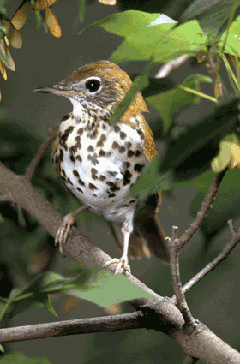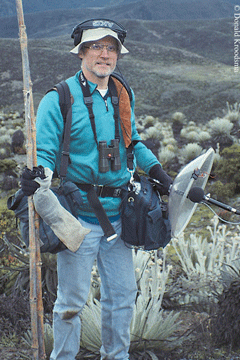The Hidden Sounds of Bird Song
Air Date: Week of May 29, 2009

Wood Thrush (Courtesy of USFWS)
Birds hear four times better than humans. That’s according to renowned bird scientist Donald Kroodsma. But what do they hear? Kroodsma recorded some of the most famous songsters – the thrushes – and slowed down the recordings in his lab, revealing the many intricate details of bird song. Producer Laurie Sanders reports.
Transcript
CURWOOD: And here’s a taste of dinosaur music.
[SOUND OF A HERMIT THRUSH]
CURWOOD: The sweet melodies of dino-descended songbirds tell us of the passage of time: the break of day, the start of spring, the end of summer.
Those same songs tell other birds who’s around, keep out of my territory, I’m looking for a mate. And bird scientists believe our ears miss much of what the songbirds themselves can hear. Producer Laurie Sanders visited a birdsong expert in Amherst, Massachusetts, to take a closer listen to some of our most talented songsters – the thrushes.
SANDERS: The song of the wood thrush is sung in the dim light of the early morning and in twilight’s quiet hours. Its sweet beauty evokes feelings about the purity and peacefulness of wild, untrammeled nature. And those sentiments come to us, even though we’re missing most of the song’s details. Birds can hear at least four times in time better than we can. Don Kroodsma is a world authority on birdsong.
KROODSMA: In some of these birds, like the wood thrush, when we listen with our unaided ear, we’re hearing a little bit of magic, enough that people proclaim this is one of the finest songsters in the world. But when you slow it down and listen to it the way I think a wood thrush itself hears it, it is absolutely mind-boggling.
SANDERS: Kroodsma says although slowing down a recording changes the pitch and timing, now we can hear the intricate details that our ears would otherwise miss.

Donald Kroodsma in the field with recording equipment (Donald Kroodsma ©)
[SOUND OF THRUSH CALL]
KROODSMA: Now we go to half speed.
[SOUND OF THRUSH CALL]
KROODSMA: Now quarter. This is where I like to listen to the first part especially.
[SOUND OF THRUSH CALL]
KROODSMA: And now all the way down to 1/8 speed.
SANDERS: To produce these extraordinary songs, songbirds have not one voice box like us, but two. The left voice box produces the lower notes, while the right voice box contributes the higher ones. Kroodsma says when a songbird sings, it’s using precision breathing—elegantly coordinated puffs. Here’s another clip from a wood thrush, this time slowed down to 1/10 speed, so that we can hear the contributions of the two separate voice boxes.
KROODSMA: So first here goes that left voice box…
[SOUND OF THRUSH CALL]
KROODSMA: …now the right…
[SOUND OF THRUSH CALL]
KROODSMA: …and now the 2 voice boxes together.
[SOUND OF THRUSH CALL]
SANDERS: And that’s just one of the twenty or so songs that a male wood thrush sings. Depending on the species, a songbird may have just a few songs in its repertoire or it might have hundreds. A brown thrasher has more than 2,000. By recording and analyzing the songs of wood thrushes, Kroodsma has discovered that wood thrushes recombine their songs randomly; he can never predict which song a male wood thrush will sing next. That’s very different, he says, than the wood thrush’s close relative-- the hermit thrush. A hermit thrush never chooses its next song at random.

Wood Thrush (Courtesy of USFWS)
KROODSMA: There’s nothing left to chance in this singing performance because what he does is choose the next song so that it’s especially different from the one he just sang. In his mind he’s got these high-pitched songs, he’s got the very low-pitched songs. He has the songs in between. And when he sings, for example, one in the mid range here, almost never would he take a baby step and go to a song on the next pitch. No, he would leap over the next possibility, and leap all the way up to the top or leap all the way to the bottom.
[HIGH PITCHED CALL]
KROODSMA: All the way up to the top.
[MID-LEVEL PITCHED CALL]
KROODSMA: Mid-level.
[LOW PITCHED CALL]
KROODSMA: All the way to the bottom.
[HIGH PITCHED CALL]
KROODSMA: Up again.
SANDERS: And that rule extends to when two male hermit thrushes are singing near each other. Each one is listening to what his neighbor is singing. If the neighbor sings high, then he sings low.
KROODSMA: There really is this exchange going on. They’re very mindful, not just that the other bird has sung, but they’re mindful of the particular song that that bird has sung, and the overall rules by which these females demand that they sing.
SANDERS: The discovery of just how much better birds can hear is relatively new, and it’s given researchers like Kroodsma new insights into the complexity of their songs, and the evolutionary forces driving that complexity. These rules of bird song that Kroodsma has studied are some of the first to be discovered, and he expects that many more will be found as researchers slow down and listen in.
[SOUND OF THRUSH CALL]
KROODSMA: Now down to – that was half, now quarter.
[SOUND OF THRUSH CALL]
KROODSMA: And then, 1/8.
[SOUND OF THRUSH CALL]
KROODSMA: Oh to be a hermit thrush for a day, to hear as they hear. It’s the only way we’ll really understand what they’re doing.
CURWOOD: Laurie Sanders is a naturalist and radio producer. She watches and listens to birds and other wildlife near her home in Western Massachusetts.
Links
Living on Earth wants to hear from you!
Living on Earth
62 Calef Highway, Suite 212
Lee, NH 03861
Telephone: 617-287-4121
E-mail: comments@loe.org
Newsletter [Click here]
Donate to Living on Earth!
Living on Earth is an independent media program and relies entirely on contributions from listeners and institutions supporting public service. Please donate now to preserve an independent environmental voice.
NewsletterLiving on Earth offers a weekly delivery of the show's rundown to your mailbox. Sign up for our newsletter today!
 Sailors For The Sea: Be the change you want to sea.
Sailors For The Sea: Be the change you want to sea.
 The Grantham Foundation for the Protection of the Environment: Committed to protecting and improving the health of the global environment.
The Grantham Foundation for the Protection of the Environment: Committed to protecting and improving the health of the global environment.
 Contribute to Living on Earth and receive, as our gift to you, an archival print of one of Mark Seth Lender's extraordinary wildlife photographs. Follow the link to see Mark's current collection of photographs.
Contribute to Living on Earth and receive, as our gift to you, an archival print of one of Mark Seth Lender's extraordinary wildlife photographs. Follow the link to see Mark's current collection of photographs.
 Buy a signed copy of Mark Seth Lender's book Smeagull the Seagull & support Living on Earth
Buy a signed copy of Mark Seth Lender's book Smeagull the Seagull & support Living on Earth

